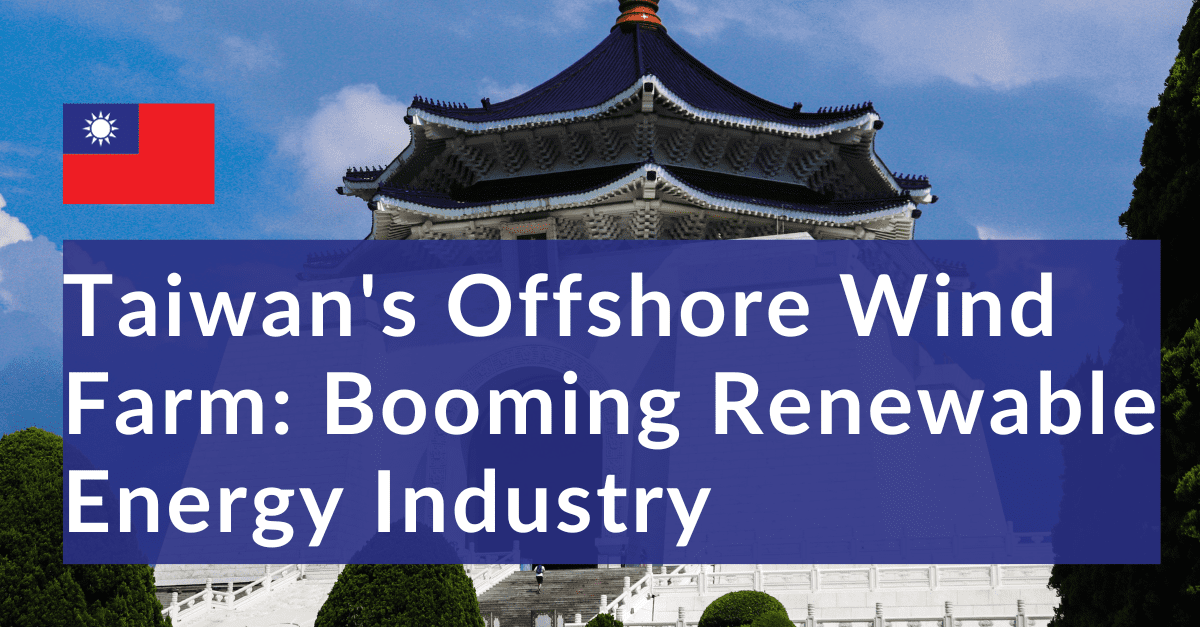Table of Contents
ToggleThe Rise of Taiwan’s Offshore Wind Farm: A Booming Industry
Taiwan has been making waves in the renewable energy sector with its booming offshore wind power industry. The government’s push towards a green economy has led to the growth of renewable energy sources, with offshore wind farms leading the charge. In this blog, we will delve deep into Taiwan’s emergence as a major player in the global offshore wind power production.
From how it all began, to the economics behind it, and the future prospects for this industry in Taiwan. We will also analyze the challenges faced by this growing industry and how they are being overcome. Lastly, we will discuss the environmental impact of these wind farms and what makes them a booming industry in Taiwan.
Table of Contents
The Emergence of Offshore Wind Farms in Taiwan
Taiwan is at the forefront of offshore wind power, experiencing rapid growth in this sector. The country has made a strong commitment to renewable energy through offshore wind, revolutionizing its energy sector. Taiwan has emerged as a global leader in offshore wind energy, with projects like Formosa 1, the nation’s first offshore wind farm, which began commercial operation in April 2017. It has an installed capacity of 128 MW.
Taiwan’s largest offshore wind farm, Formosa 2, has 47 wind turbines and a capacity of 376 MW, providing clean energy for 380,000 households. Additionally, the upcoming Formosa 3 wind farm will be constructed offshore Changhua County.
Taiwan’s Offshore Wind Power: How Did It Begin?
In the beginning, Taiwan’s offshore wind power journey was kick-started by government initiatives and enabled by legal frameworks. Collaborations with international partners jumpstarted offshore wind projects. With its geographical advantage, Taiwan harnessed the potential of offshore wind power as a strategic priority for energy security. This industry has seen remarkable growth, from 2 demonstration turbines to 90 in just five years.
The Economics of Offshore Wind Power in Taiwan
Investment costs and economic viability are crucial considerations for offshore wind projects in Taiwan. The sector’s growth not only contributes to the country’s economic expansion but also creates jobs and brings economic benefits.
Factors such as technology advancements, government policies, and economies of scale influence the financial feasibility of these projects. Balancing economic considerations with environmental sustainability is a key challenge in the offshore wind sector, as Taiwan seeks to harness the potential of this renewable energy source.
According to Lee Chun-li, the deputy director-general of Taiwan’s Bureau of Energy, offshore wind plays a critical role in enhancing energy security for Taiwan, a country that relies on imports for 98% of its energy needs. Lee also mentioned that by 2025, it is anticipated that offshore wind will attract investments worth approximately T$1 trillion ($32.6 billion).
The Environmental Impact of Offshore Wind Farms in Taiwan
Offshore wind farms in Taiwan have taken measures to mitigate their impact on marine life and habitats. During construction, efforts are made to assess and minimize underwater noise. Bird collisions with wind turbines are monitored and managed to protect avian species.
The effects of electromagnetic fields on marine life are evaluated to ensure their safety. Furthermore, marine spatial planning is enhanced to safeguard sensitive areas. These initiatives demonstrate the commitment of offshore wind farms in Taiwan to minimize environmental impact.
Addressing Environmental Concerns and Marine Spatial Planning
To ensure the sustainability of offshore wind projects, thorough environmental impact assessments are conducted. Best practices in marine spatial planning are implemented to minimize conflicts and protect biodiversity through collaboration with marine biologists and conservationists.
The design of offshore wind farms takes into account minimizing visual impacts on coastal landscapes. Additionally, monitoring and mitigation measures are in place to address the effects of underwater construction noise, ensuring minimal disruption to marine ecosystems.
What Makes Taiwan’s Offshore Wind Farms a Booming Industry?
Taiwan’s offshore wind farms are thriving due to several factors. Abundant wind resources and favorable offshore conditions provide ideal locations for wind energy generation. The government’s commitment to renewable energy and offshore wind development, along with attractive feed-in tariffs and power purchase agreements, have attracted investors.
Additionally, Taiwan has a strong domestic supply chain and manufacturing capabilities, as well as international collaboration in offshore wind technology.
Taiwan’s Place in Global Offshore Wind Power Production
Taiwan’s offshore wind power capacity ranks among the top four in the world, after China, the U.K., and the U.S. This places Taiwan in a pivotal position in global offshore wind power production.
Taiwan’s offshore wind industry is not only contributing to the global clean energy transition but also learning valuable lessons from offshore wind pioneers like Germany and the UK. With collaboration opportunities between Taiwan and other offshore wind markets, Taiwan has the potential to become a world leader in offshore wind power production.
Comparing Taiwan with Germany, Belgium, Australia, France, UK, Japan, and America
Germany, Belgium, and the UK have made significant strides in scaling up offshore wind power. Australia and France are also making efforts to tap into the offshore wind potential in their respective regions. Japan and America have been advancing offshore wind technology, contributing to the growth of the global industry.
Each market presents unique challenges and opportunities. Collaborative efforts among these global players aim to accelerate offshore wind development.
Future Prospects for Offshore Wind Power in Taiwan
Taiwan has set ambitious targets for expanding its offshore wind capacity with ambitious plans to reach 15 GW by 2035, indicating a promising future for the industry. Technological advancements are shaping the future of offshore wind in Taiwan, leading to innovative opportunities for research and development.
Despite challenges, such as legal and infrastructural issues, the industry is determined to achieve sustainable growth. By paving the way for a greener and more sustainable future, offshore wind power in Taiwan is positioned to play a significant role in meeting the nation’s renewable energy goals.
Challenges in Taiwan’s Offshore Wind Power Industry
Overcoming legal and regulatory hurdles, developing robust infrastructure, ensuring grid connection and stability, managing environmental impacts and stakeholder concerns, labour challenges, and establishing a strong supply chain are key challenges in Taiwan’s offshore wind power industry.
To navigate these obstacles, stakeholders work to streamline permitting processes, invest in port facilities and transmission infrastructure, conduct comprehensive impact assessments, engage with local communities, and foster collaboration between government and industry.
How can an Employer of Record help with Taiwan’s Offshore Wind Farms and Renewable Energy Industry?
An Employer of Record (EOR) can play a crucial role in the success of Taiwan’s offshore wind farms and renewable energy industry. With its expertise in managing human resources, compliance, and payroll services, an EOR can help companies navigate the complex labor challenges that often arise during the development and operation of offshore wind projects.
One of the main challenges faced by the industry is onboarding skilled workers with experience in offshore wind technology within a certain period of time. An EOR like Eos Global Expansion can assist in onboarding qualified personnel, ensuring that companies are able to start and complete their projects on time.
Conclusion
The development of Taiwan’s offshore wind farm industry is not without its challenges. However, with the support of stakeholders and the assistance of an Employer of Record (EOR) like Eos Global Expansion, these obstacles can be overcome. By streamlining processes, investing in infrastructure, and ensuring a skilled workforce, Taiwan is on track to meet its renewable energy goals. With the continued collaboration between government and industry, Taiwan’s offshore wind farms are poised to make a significant contribution to the nation’s clean energy future.







